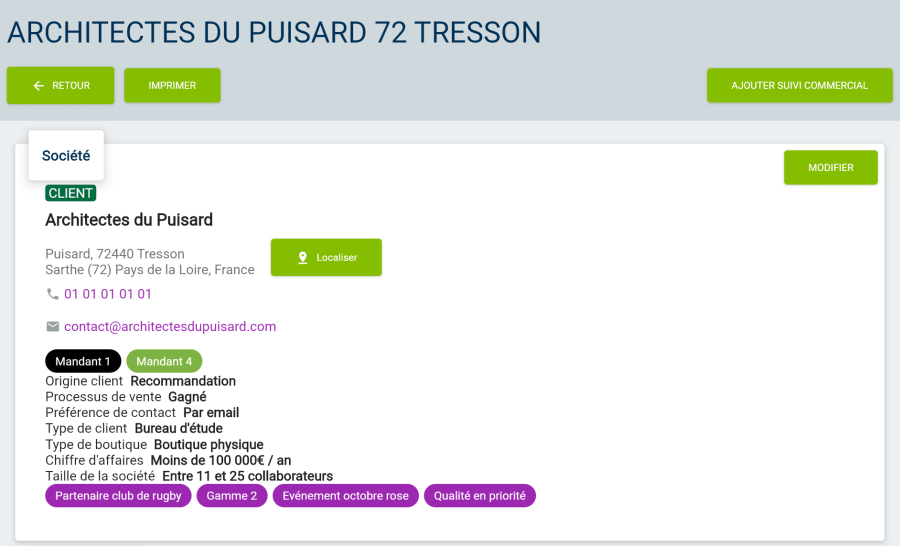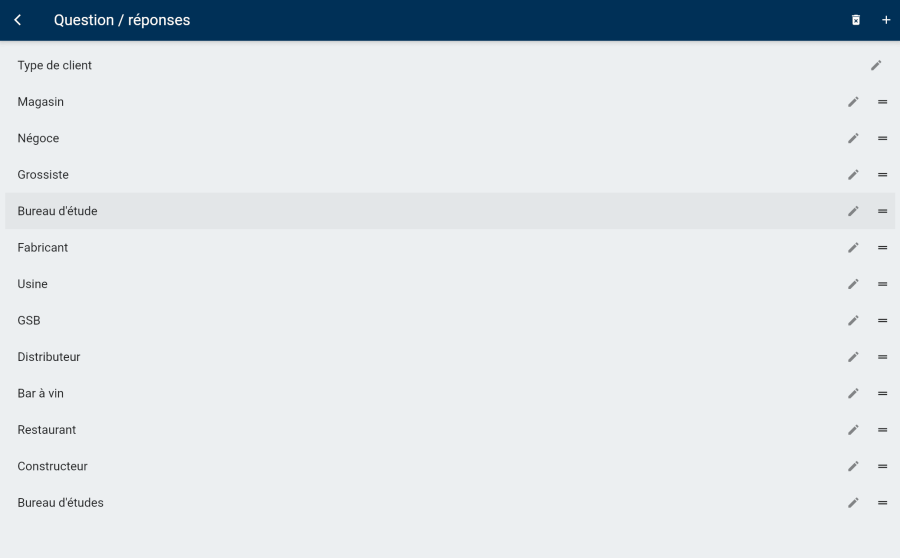To manage customers properly, you need to know how to identify their characteristics.
Knowing how to recognize the behavior of the customer in front of you can make the difference between a successful sale and a lost opportunity. In this article, we’ll explore 11 major customer types:
- The customer is king,
- The impassive or reserved customer,
- The hesitant or indecisive customer,
- The skeptical customer,
- The wary customer,
- The opportunistic or thrifty customer,
- The litigious customer,
- The (very, very) hurried customer,
- The chatty customer,
- The egocentric customer,
- The irrational customer.
Of course, this typology is not exhaustive. We strongly encourage you to adapt and personalize this customer typology according to your personal experience, your sector of activity, and so on.
Let’s start by discovering these 11 customer archetypes that may cross your path.
What are the 11 main types of customer?
1. The customer is king
The king customer is the demanding customer par excellence, the one who fully embodies the expression “the customer is king”.
How do you recognize the king customer?
- High standards,
- Perfectionist and sometimesa little temperamental,
- Expects special treatment from sales or customer service.
Our tips for dealing with the king customer:
- If you’ve identified that your customer is of this type before the appointment, take care to prepare him or her in advance: you’ll arrive more confident and will already have anticipated his or her behavior and arguments,
- Present yourself in a professional and polished manner, showing that you value the relationship,
- Listen to your customers’ specific needs and requests,
- Anticipate potential needs and propose proactive solutions.
2. The impassive or reserved customer
How to recognize the impassive customer?
- Generally calm, can be introverted,
- Doesn’t reveal his emotions easily, and is hard to pin down.
- Does not speak or speaks very little,
- Appears distant or disinterested.
Our tips for dealing with the impassive customer:
Sometimes this type of customer adopts this behavior to hide a certain mistrust of your sales approach, or to hide the fact that they’re uncomfortable.
- Early on in your date, try to break the ice (build on common ground, try to lighten the mood with a joke, etc.). See how these attempts are received, and adapt accordingly,
- Encourage them to express themselves by asking only open-ended questions:“What do you expect from our products/solutions? What do you think?”
- Use this information to refocus the conversation on what motivates him and address his concerns.
3. The hesitant or undecided customer
How do you recognize a hesitant or indecisive customer?
- Has difficulty making decisions (asking for time to think, for example),
- Expresses doubts or reservations about your products or services,
- Depending on his or her interest, will seek information to make a decision.
Our tips for dealing with the indecisive customer:
- Identify your customer’s doubts and obstacles: open-ended questions and listening are a winning combo for this,
- Show active listening and empathy,
- Offer options and alternatives to give her a sense of control,
- Strengthen your role as advisor and coach.

The free cheat sheet to help you better understand your customers
Use the CAP SONCAS method to analyze your customers’ and prospects’ deep-seated motivations, so you can convince them more effectively.
Download our free CAP SONCAS model chart and the method’s summary sheets.
4. The suspicious or skeptical customer
How do you recognize a skeptical or distrustful customer?
- Ask for concrete examples or testimonials from satisfied customers,
- May call into question your word or your good faith,
- Look for proof of your claims, or verify the information you provide.
Our tips for dealing with this type of customer:
- Be well prepared and demonstrate in-depth knowledge of the product or service,
- Provide tangible evidence, such as statistics, case studies or testimonials,
- Use logical arguments to support your points of view. Avoid playing on emotions or subjective opinions,
- Engage in constructive discussions and avoid reacting defensively,
- Remain available for follow-up discussions and clarifications.
5. The demanding customer
How do you recognize a demanding customer?
- Like the king customer, has high quality standards and strict expectations,
- However, you can reason with him, and he doesn’t necessarily expect special treatment,
- Ask detailed questions about every aspect of the product or service,
- Seeks trusted partners and expects impeccable service.
Our tips for dealing with this type of customer:
- As with the king customer: come prepared! Study the information you already have, and make sure you’ve mastered your subject to anticipate the toughest questions,
- Demonstrate your expertise and the quality of your offer,
- Highlight satisfaction guarantees and proof of quality,
- Maintain a high level of professionalism and reliability in all interactions.
6. The opportunistic or thrifty customer
How to recognize the thrifty customer?
- This customer is looking for the best deal and wants to save money,
- He can be pragmatic and price-sensitive,
- It is very sensitive to promotions and discounts.
Our tips for managing the frugal customer:
- Highlight the financial benefits of your offer,
- Explain how your product or service can help save money in the long term (even if it means showing cost comparisons to demonstrate profitability),
- Offer promotions or discounts to attract his attention,
- Be prepared to negotiate on price or conditions.
7. The litigious customer
How do you recognize this type of customer?
- Understand every step of the sales process,
- Will need reassurance and transparency,
- Preoccupied with details and procedures,
- Appreciates organization and clarity.
Our tips for dealing with the litigious customer:
- From the very start of the relationship, make sure your communication is structured and transparent,
- Make sure you keep your commitments and promises,
- Respect your customers’ communication preferences and choices,
- Be prepared to answer specific process questions.
8. The (very, very) hurried customer
How do you recognize a customer in a hurry?
- Little or no time for discussion,
- Prefers fast, efficient interactions,
- May ask you to complete an action within an untenable timeframe (and not always in the most pleasant of ways).
Our tips for dealing with customers in a hurry:
- Offer quick communication options such as phone calls or short e-mails,
- Be punctual and strictly adhere to deadlines,
- Anticipate its needs and be ready to provide information quickly,
- Make sure you have a fast, efficient customer management platform to respond to customer requests.
9. The chatty customer
How do you recognize a chatty customer?
- Likes to share personal details, and chat in general,
- Often deviates from the main subject,
- Looking to make personal connections.
Our tips for dealing with chatty customers:
- At the start of the appointment, set a time for the end of the appointment:“Today, I only have an hour for our meeting, as I have to go to another customer’s afterwards. Does that suit you?“
- Show interest in his stories and comments,
- Ask targeted questions to steer the conversation towards the purpose of the appointment.
10. The egocentric customer
How do you recognize the egocentric customer?
- Often talks about himself and his achievements, which can be personal or professional,
- Wants to be the center of attention,
- Is convinced he’s right,
- Can expect special treatment (a bit like the king customer).
Our tips for dealing with this type of customer:
- Be diplomatic and empathize with their concerns: who knows, maybe you’ll be able to link their concerns to your offers?
- Be clear and transparent to anticipate excessive demands,
- Use language that enhances and promotes it.
- Make sure you have an effective customer management platform to tailor your approach to their needs.
11. The irrational customer
How do you recognize this type of customer?
- Makes impulsive decisions based on strong emotions,
- Behavior may be difficult to anticipate or understand,
- Remains insensitive to logical arguments.
Our tips for dealing with irrational customers:
- Be patient and actively listen to what he tells you to find out what motivates him personally,
- Offer flexible solutions to meet changing needs,
- Provide regular follow-up to keep the lines of communication open,
- Make sure you have an effective customer management platform to track changes in customer needs and behavior.
Managing every type of customer with the SONCAS method
Now that we’ve explored the 11 main types of customer, you may be wondering how you can better understand their needs and motivations.
This is where the SONCAS method comes in.
Conceptualized by Jean-Denis Larradet in 1993, the SONCAS method is a sales technique that synthesizes the 6 types of buying motivation: Security, Pride, Novelty, Comfort, Money and Sympathy. SONCAS-E is increasingly used, with the addition of an E for Environment:
- Security: Security-conscious customers want reliable products or services. They need to feel confident in their purchasing decision. For customers who are undecided, cautious or skeptical.
- Pride: Pride-driven customers are sensitive to image and reputation. Emphasize the quality and/or high-end nature of your products or services. For royal customers.
- Novelty: This type of customer is always looking for something new and exciting. They love innovation and trends.
- Comfort: Comfort-conscious customers want solutions that are simple and easy to use. Reassure them by emphasizing this aspect of your product range.
- Money: For these customers, price is everything. They’re looking for bargains and discounts.
- Sympathy: Sympathy is the main motivation for some customers. They are sensitive to ethical values and social responsibility. Hubspot reported in 2020 that 50% of B2B customers buy based on the salesperson and not on the solution sold per se.
- Environment: Is your customer sensitive to environmental issues?
By using the SONCAS method, you can go beyond the broad customer types we’ve seen, and fine-tune your sales approach according to each customer’s specific motivations.
For example, if you identify that your customer is motivated by safety, you’ll emphasize the reliability of your product or service.
What criteria should you take into account when structuring your customer typology?
Criteria for segmenting B2C contacts or targets
While these behavioral criteria can be interesting to analyze, they are obviously not sufficient to segment all types of customer.
Other criteria also used to sort contacts, such as :
Socio-demographic criteria: e.g. age, gender, family situation, occupation, income, etc.
Purchasing behavior: for example, frequency of purchase, average amount spent, preferred products or services, etc.
Communication preferences: does your customer prefer to communicate by e-mail? Or a phone call? SMS?
Specific needs Sort your contacts according to the “problem” to be solved and/or the objectives to be achieved by your customer.
It’s up to you to choose the most relevant criteria according to your target, your objective and your market.
Criteria for segmenting your B2B contacts
Here are some ideas of criteria to consider for your segmentation:
- Customer status : lead, prospect, suspect, customer,
- Origin of contact : How did you come into contact with this company?
- Your customer’s sector of activity or type of service :
- If you sell building materials, you’ll use the following classification: design office, craftsman, merchant…
- If you offer cleaning services, you’ll be more interested in the following segmentation: Offices, Stores, Sports halls, Public buildings…
- Sales revenue: for example, under €100,000, between €100,001 and €500,000, over €500,000…
- The parent brand: very important for sorting your contacts easily, if for example you visit stores belonging to different brands (e.g. E.Leclerc, Carrefour…),
- Company size: i.e. number of employees,
- The specific need: in the same way as for your contacts, determine what this company needs.
Customer segmentation with Moovago
From customer typology to customer segmentation
Managing customer typology may seem complex, but tools such as a CRM can greatly simplify your day-to-day work.
In Moovago, each of your customers has a detailed file where you can record essential information. At a glance, you have access to all the important information about this customer:
- The name,
- The address,
- Contact information,
- The principals concerned (if you manage different brands),
- Segmentation questions and answers,
- As well as additional information in the form of labels.

Complete your customer segmentation with labels
In this example, to complete the segmentation, we use Moovago tags to better classify and quickly find the type of customer…
Unlike segmentation questions, which have only one correct answer, labels can be added without restriction.
For example: this customer took part in such and such an event, is also a partner of a rugby club, and is sensitive to the quality of our services.
This allows you to add information to each customer based on their specific characteristics and behaviors.
How to create a customer segmentation with Moovago in 3 steps?
What’s so special about Moovago’s managed segmentation? It’s YOUR segmentation. In other words, you can customize your segmentation as you see fit.
From the parameters, create segmentation questions (e.g. customer type)…

… then personalize the possible answers to this question. For example: store, trade, wholesaler, design office, etc.

Then all you have to do is associate the right answers and labels with the companies, and you’ll have a well-structured customer database. Ideal for quick access to information, and for sorting thousands of companies in just a few clicks!
Conclusion
To obtain the most complete customer typology possible, it’s advisable to take into account both behavioral and more traditional criteria.
Don’t forget that each segmentation must be customized to suit your needs, and allow you to quickly categorize and sort your contacts!
